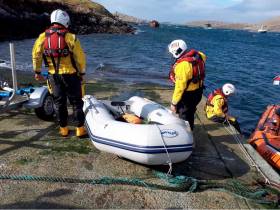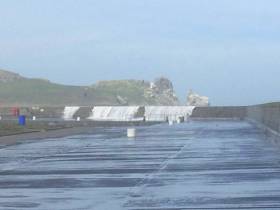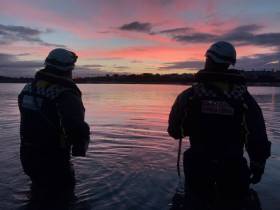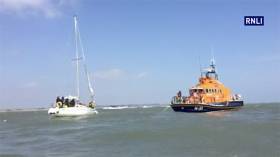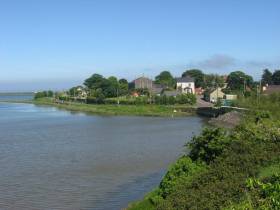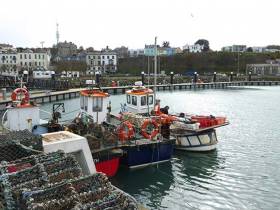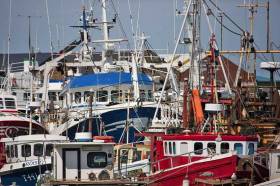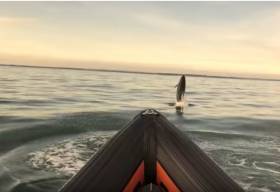Displaying items by tag: Howth
#RNLI - Minutes after participating in the local St Patrick’s Day parade on Saturday 17 March, Clifden RNLI joined a full-scale search and rescue operation for two spear divers reported missing.
Clifden’s all-weather and inshore lifeboats were tasked alongside Achill RNLI, the Sligo-based Irish Coast Guard helicopter Rescue 118 and the Cleggan Coast Guard Unit in the search for the two men that had left Rossroe pier that morning in a small inflatable boat to go spear fishing on the north side of Killary Harbour. The men had not been since that morning.
At 1.12pm, Clifden RNLI’s all-weather lifeboat Fisherman’s Friend was prepared for launch with coxswain Alan Pryce, mechanic Robert King, navigator Owen Hayes and crew members Tom Davis, Kieran Folan and David Coyne.
The D class inshore lifeboat Celia Mary was transported by road to Rossroe and was crewed by helm James Mullen and crewed by Brian Ward, David O’Reilly and Ian Shanahan. Shore crew volunteer Fergal Conneely drove the Land Rover with the inshore lifeboat in tow to launch at Rossroe pier.
Clifden’s inshore lifeboat shortly after arrived on the scene joining Rescue 118. The crew were briefed by the local fisherman who had reported the spear divers missing.
When he was out fishing about 90 minutes previously, he had seen them spear fishing on the north side of the bay with a small inflatable with an outboard engine. However, he hadn’t seen them or their inflatable since, and as their van was still on the pier, with the weather deteriorating, he decided to call for assistance.
Weather conditions had a north-easterly Force 5-6 wind as Rescue 118 were conducting an aerial search of the bay. The lifeboat crew then spotted a small inflatable with two people onboard trying to hang onto a barge.
Clifden RNLI helm James Mullen said: “I informed Rescue 118 of the possible sighting and they proceeded to the area with us. When we arrived on scene, the two men informed us that they were the two missing spear divers.
“Their engine had broken down and they had tried to swim the across the bay with their boat but it had become swamped. Their legs had cramped and they were both exhausted. We towed them back to the pier at Rossroe and helped them recover their boat at 2pm.”
Clifden RNLI lifeboat operations manager John Brittain added: “The inshore D Class lifeboat Celia Mary, which was just named in a ceremony last year, has once again proved how much of a valuable asset it is to our station.
“We are delighted to have been able to respond and bring these people to safety and are also very thankful for the vigilance of the local fisherman who raised the alarm and potentially avoided a much worse outcome today.”
Elsewhere on Saturday, Howth RNLI launched its all-weather lifeboat to reports of an upturned kayak spotted in rough seas off the nose of Howth.
A member of the public, while out walking on Howth Head, spotted what appeared to be a yellow upturned kayak just off the nose of Howth in very rough water and raised the alarm with the Irish Coast Guard, sending them a picture taken with their smartphone.
Howth RNLI was immediately tasked to investigate, with crew pagers sounding at 5.45pm and the lifeboat launched within 12 minutes. Weather conditions saw a very rough sea state in Force 6-7 easterly winds.
Despite the poor conditions, the kayak was quickly located and brought aboard the lifeboat. It looked like it had not been used for quite some time and had been adapted to support a floating structure. The lifeboat completed a search of the area and returned to base.
Speaking following the callout, Howth RNLI station mechanic Ian Sheridan said: “We have to compliment the member of the public for their quick action. While in this case it was thankfully a false alarm, the accuracy of their report to the coastguard allowed us to find the reported vessel and conduct a search.”
Howth Sees Storm Protection Plans For East Pier
#Howth - The response was mixed from locals for plans for storm protection works at Howth Harbour, as The Irish Times reports.
The Department of the Marine hosted an information day in the North Co Dublin village yesterday (Wednesday 17 January) outlining a proposal to reinforce the East Pier, which has long been susceptible to waves crashing over the top in heavy weather.
But the structural improvements, which are likely to progress to the planning stages later this year, would see the popular pier closed to the public for at least eight months.
The Irish Times has more on the story HERE.
Night Rescue Of Kerry Surfer From Foggy Cliffs
#Rescue - A surfer was rescued in West Kerry on Monday night (22 May) after he was pulled from the shore by a rip current, as RTÉ News reports.
Dingle Coast Guard and Valentia RNLI fought difficult conditions – with a heavy swell and thick fog – to locate the man, who had managed to climb onto rocks beneath high cliffs near Com Dhíneol, a popular surfing spot.
The incident occurred just weeks after a Scottish surfer was rescued off Northern Ireland after more than 30 hours at sea.
Elsewhere, gardaí are continuing to investigate after a person was reportedly spotted in difficulty in the water near Sutton Dinghy Club on Monday night.
Howth Coast Guard and RNLI lifeboat crews from Howth and Dun Laoghaire found nothing on their low water searches, concentrating on the area between Sutton and Dollymount Strand and returning twice more, before dawn on Tuesday (23 May) and later that afternoon.
Stranded Yacht Towed To Safety By Howth Lifeboat
#RNLI - Howth RNLI launched its all-weather and inshore lifeboats yesterday (Monday 1 May) to reports of a sailing yacht with steering failure at the entrance to Malahide Estuary.
The inshore lifeboat was first on scene and located the casualty vessel just after noon. The 30ft sailing yacht, with five people aboard, was experiencing steering problems and unable to safely manoeuvre.
Weather conditions at the time had a moderate sea state in Force 4-5 winds.
The all-weather lifeboat arrived on scene shortly after and secured a towline to the stricken yacht before towing it to the safety of Howth Marina.
Both the inshore and all-weather lifeboats returned to station and were stood down following the successful rescue.
Speaking after the callout, Howth RNLI duty coxswain Ian Sheridan said: “We were delighted to assist the five crew of the sailing yacht after they found themselves with no steering at the entrance to Malahide Marina.
“They quickly radioed for assistance which was the correct thing to do and we were able to launch and tow the yacht to safety.”
Boyne Boat Capsize Trio ‘Lucky To Be Alive’
#Coastguard - Three people are “extremely lucky to be alive” after their boat upturned on the River Boyne last night (Monday 17 April), as TheJournal.ie reports.
The three casualties rescued east of Mornington, Co Meath were found to be not wearing lifejackets when they were rescued by volunteers from Drogheda Coast Guard.
Clogherhead RNLI also attended the incident, which occurred east of Drogheda Port, after a member of the public raised the alarm around 9.30pm.
“Only for the quick thinking of the caller and the rapid response from all agencies involved were we able to bring this incident to a successful conclusion,” said an Irish Coast Guard statement.
Elsewhere, DublinLive reports on Howth Coast Guard’s rescue of two kayakers stranded at Ireland’s Eye on Saturday afternoon (15 April).
The coastguard volunteers were on exercise when by chance they happened upon the kayaking duo, who had set out with no means to call for help.
Ireland’s Six Fishery Harbour Centres & Small Harbours Get €28m In Funding For Capital Projects
The Minister for Agriculture, Food and the Marine, Michael Creed TD, today announced details of a €28m Capital Investment Package for the ongoing development of Ireland’s Local Authority owned small harbour network. (see Table 1 below for details)
In announcing the initiative the Minister said “The €28m I am allocating for the 2017 Fishery Harbour and Coastal Infrastructure Capital Programme represents a significantly increased capital investment in the six Fishery Harbour Centres and other fisheries related marine infrastructure. It is testament not only to this Governments ongoing commitment to the Seafood sector, but also to the success of the sector in terms of increased activity levels.”
The Annual Fishery Harbour and Coastal Infrastructure Capital Programme provides funding for development works, safety and maintenance at the six Fishery Harbour Centres at Howth, Dunmore East, Castletownbere, Dingle, Ros an Mhil and Killybegs. The primary function of the Fishery Harbour Centres is to underpin the ongoing development of the fisheries and seafood processing sectors, while also facilitating other diverse marine related activities. The annual value of all fish landings into the six Fishery Harbour Centres increased from €136.8m to €262.3m over the period from 2010 to 2015.
The Minister said “I have set aside almost €25.5m towards development works, safety and maintenance at the six Fishery Harbour Centres which account for around 85% of all fish landed into Ireland. I have also proved €2.5m for a Local Authority Harbour Development and Marine Leisure programme to assist coastal Local Authorities in the repair and development of small scale piers, harbours and slipways under their ownership.”
Flagship projects in the 2017 Capital Programme include major quay extensions at Castletownbere, Killybegs, and Howth. Also of note is the dredging of the navigation channel in Dingle, the completion of the Small Craft Harbour in Ros an Mhíl and the West Wharf upgrade in Dunmore East.
The Minister concluded by saying “This €28m investment will build on the €64m invested in the Fishery Harbour Centres since 2010 and the €23m invested in the Local Authority infrastructure over the same period. It continues to improve the facilities at our Fishery Harbour Centres and other public harbours around our coast attracting increasing and additional economic activities, benefitting a broad cohort of current and future harbour users including the fishing industry, seafood processing sector, other ancillary marine industries, and the wider rural coastal communities”.
Table 1- Fishery Harbour & Coastal Infrastructure Development Programme 2017
| Table 1. | ||||
| Location | Project Description | Cost €m | ||
|
Howth:- |
Construction of additional berthing face to middle pier and dredging along pier face. Gas Main Other Services (Sewers, ducting, watermains) Claremount Storage Units East Pier Repairs Syncrolift – Timber Deck Footpath Upgrade |
1.50 0.15 0.15 0.15 0.17 0.05 0.15 |
||
| Total | 2.32 | |||
|
Dunmore East:- |
West wharf upgrade required due to steel corrosion and spalling of concrete. Shanoon Car Park |
0.4 0.2 |
||
| Total | 0.6 | |||
|
Castletownbere:- |
Dinish island pier extension New Harbour Administration Building (shared facility) on mainland Quay. Harbour Slipway |
5.0 1.2 0.3 |
||
| Total | 6.5 | |||
|
Dingle:- |
Dredging North Channel to widen the navigation channel to the port and provide better access. Upgrade of Harbour Marine Facilities Building |
4.0 0.2 |
||
| Total | 4.2 | |||
|
Ros an Mhíl:- |
Small Craft Harbour final Phase (furniture fit out and services). |
0.8 |
||
| Total | 0.8 | |||
|
Killybegs:- |
Smooth point pier extension and permitting. Harbour Electrics Upgrade Small Craft Harbour final completion. |
5.0 0.5 0.7 |
||
| Total | 6.2 | |||
| Total Fishery Harbour Centres( new developments) | 20.62 | |||
| Cape Clear | Complete development works incl painting stoplogs, install pontoons, finish road works. | 0.1 | ||
| Safety and Maintenance and Non-Discretionary and Contractual Capital Commitments (incl Disability Access) | 4.69 | |||
| Total Local Authority Harbour Development and Marine Leisure Programme | 2.50 | |||
| Total 2017 Fishery Harbour and Coastal Infrastructure Capital Programme | 27.91 | |||
‘Ireland AM’ Presenter In Trolley Dash For Howth Lifeboat
#RNLI - Aidan Cooney, a presenter on TV3’s Ireland AM, took part in a ‘trolley dash’ around SuperValu Sutton this past Tuesday (20 Dec 2016) in an effort to raise much-needed funds for Howth RNLI.
As a result, SuperValu Sutton donated a cheque for over €1,600 to the local lifeboat station.
“I’ve nothing but admiration for the staff and volunteers of the RNLI,” said Cooney. “The lads at Howth and every other station provide a 24-hour search and rescue service 365 days a year.
“It was a no-brainer to donate the Trolley Dash to the lads and it was great fun chasing up and down the aisles of SuperValu Sutton.
“Big thanks to Neville and his staff who kindly exchanged the groceries for a hard cash donation to what is a vital service manned by volunteers.”
Rose Michael, Howth RNLI fundraising chair, thanked Cooney for taking time out of his busy schedule, and expressed “admiration for his speed around the aisles”.
Michael added: “We have been so lucky to have such incredible support from SuperValu Sutton as their Charity of the Year 2016. They have been unstinting in their efforts to raise funds for Howth RNLI and I’d like to thank them for today’s generous donation.”
Just a few days previously, Howth RNLI received a cheque for €5,525 from the Lough Lene Angling Association, raised as a result of the club’s annual charity fly-fishing competition organised by the Midlands Angling Club.
“Every year we hold a fly-fishing competition and raise money for charity,” said Tommy Fagan, chair of the Lough Lene Angling Association. “We’ve raised over €30,000 over the last eight or nine years.
“The Howth RNLI Community Safety Team carried out a life jacket clinic with us earlier this year, so it was decided that Howth RNLI would be the competition’s Charity of the Year 2016.”
Howth RNLI’s community safety officer said the money raised “will help to fund our Respect the Water safety campaign, and the running of lifejacket clinics with angling and water sports clubs.
“It will also go towards the cost of training and kitting out Howth RNLI’s volunteer lifeboat crew so they are ready to save lives at sea when their pagers sound.”
Piling & Pontoon Installation Works At Howth Trawler Dock
#MarineNotice - Marine Notice No 46 of 2016 advises that piling works were set to commence at Howth Fishery Harbour Centre, weather permitting, on or around this past Monday 21 November.
The works involve the installation of 3 No. circular steel piles and the subsequent installation of a floating pontoon at the trawler dock (Western Basin) at latitude 53°23'32” N and longitude 6°4’6” W.
The works are being advanced by a marine contractor working from a jack-up barge 18m x 18m in size, using heavy civil engineering plant and machinery, work vessels and platforms. Divers will be employed onsite to install anodes to the piles.
For safety reasons, mariners are requested to proceed slowly and with caution in the trawler dock and to give the works a wide berth. Wave wash from vessels should be avoided.
These works are expected to be ongoing until the end of December 2016, weather permitting.
Coast Guard RIB Gets Unexpected Company off Howth (VIDEO!)
The Howth–based Coast Guard boat “Sean A Dunne” was joined by some unexpected visitors today in the form of a school of Bottlenose Dolphins.
The Coast Guard crew of four from Howth station were on routine exercise in the Irish Sea off Donabate, Co Dublin in what was flat calm clear conditions.
The dolphins joined the crew surfing the bow waves of the Coast Guard boat before heading back to deeper waters.
Howth RNLI Rescues Man From Sea after Jet Ski Gets into Difficulty
Howth RNLI rescued a man who got into difficulty on a jet ski this afternoon and ended up in the water east of Ireland’s Eye.
The volunteer lifeboat crew was requested to launch both their inshore and all-weather lifeboats at 3.35pm following reports that a man was missing in the sea after his jet ski developed engine difficulties.
The alarm had been raised by a companion of the casualty’s who had come ashore on his own jet ski.
The two men had left Howth harbour earlier in the day before one of their jet skis encountered problems.
The lifeboats quickly travelled to the reported area between Balscadden and Ireland’s Eye and commenced a search.
Weather conditions at the time were described as good with clear visibility. However, the sea was quite rough with strong easterly winds generating large breaking waves in the vicinity of Ireland’s Eye.
As Afloat.ie reported earlier, the Irish Coast Guard helicopter Rescue 116 was also tasked to the search. Using its onboard search equipment, the helicopter quickly located the casualty who had drifted quite a distance from his original location.
Following this communication from the Coast Guard helicopter, the all-weather lifeboat proceeded to the scene and rescued the casualty who was found clinging to the jet ski. He had been in the water for approximately 30 minutes. Once onboard the lifeboat, the crew began to administer casualty care to man who was extremely cold.
Arriving back at Howth Lifeboat Station, the man was transferred from the lifeboat into a waiting ambulance where he was treated for hypothermia.
The inshore lifeboat meanwhile took the stricken jet ski in tow and returned it to the safety of Howth Harbour.
Speaking following the call out, Colm Newport, Howth RNLI Lifeboat Operations Manager said: ‘Time was of the essence this afternoon as the casualty was in the water for some time. Team work was at the centre of this call out and with thanks to our colleagues in the Irish Coast Guard who located the casualty once onscene, we were able to rescue the man and bring him ashore. We would like to wish both him and his companion well following their ordeal.’


























